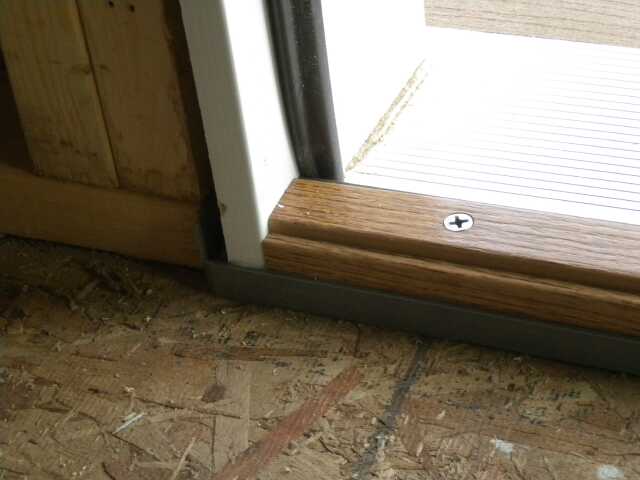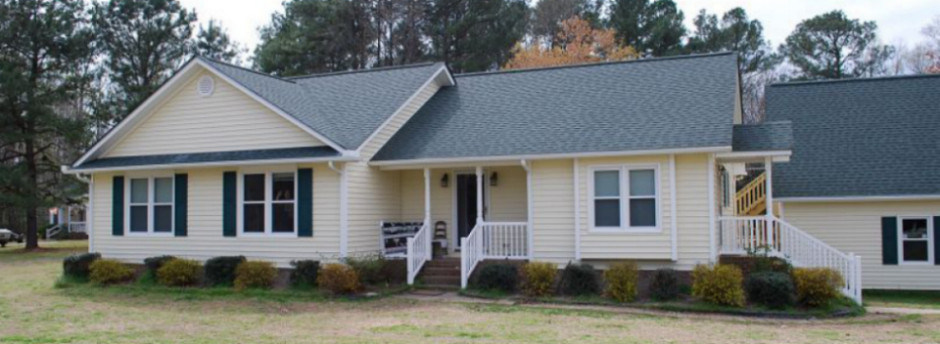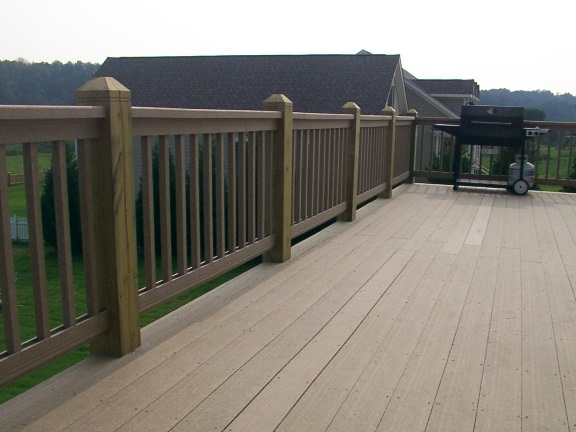Door Threshold Adjustment
I recently “talked” (via Facebook’s private text feature) my daughter through the process  of adjusting her front door threshold, in an effort to keep out invading beetles. While I was going over some of the finer points of adjusting the door threshold, I realized how often I preformed this service for my clients. Since she was so successful in adjusting her front door threshold, I thought it would make a good post on my blog, so here goes.
of adjusting her front door threshold, in an effort to keep out invading beetles. While I was going over some of the finer points of adjusting the door threshold, I realized how often I preformed this service for my clients. Since she was so successful in adjusting her front door threshold, I thought it would make a good post on my blog, so here goes.
Not every threshold is adjustable, but for those that are, proper door threshold adjustment will lead to longer life, less wear, a weather tight seal and most importantly a door that opens and closes easily.
If your door is drafty along the bottom, allows light to show underneath or admits bugs or spiders the door threshold needs adjusting or, on non adjustable thresholds, replacing.
To determine if a door threshold is adjustable look for several dime sized snap out caps along the tallest part of the threshold . Beneath these caps are brass screws that adjust the threshold up and down. On some door thresholds the screws are always visible. Tuning them in one direction will raise the threshold the other direction will lower it.
Steps for proper door threshold adjustment
Before attempting any adjustment, close the door and observe the rubber sweep on the bottom of the door. It should be barely touching the adjustable part of the threshold. This can be ascertained by placing a light source on the opposite side of the door and looking for light seeping under. Alternately a piece of paper may be placed over the threshold of the door while it’s in the open position and then closing the door over it. If light is visible under the door or the paper moves easily along the bottom of the door, the threshold is not fitting tight enough. If the paper is torn when closing the door or the door is too difficult to close the threshold may be too tight.
The bottom of the door should have some type of sweep (rubber gasket or fins) that are slightly compressed as the door is closed over the threshold. It is possible that the threshold is tight enough in some areas and has a gap in others. The adjustment screws must be utilized to bring the adjustable part of the threshold parallel with the bottom of the door and just snug enough to seal without binding the door when it is being closed.
Tips for proper door threshold adjustment:
- don’t make any adjustment until you are sure it is required
- determine a plan of action – don’t just start turning screws
- make small adjustments and check for proper closure after each adjustment.
- make sure the door threshold is adjusted properly along it”s entire length
- DO NOT adjust the threshold up too much. If the door closes too tight it will result in excessive wear and premature failure of the door sweep.
Did you enjoy this post? Tell us what you think in the comments box below.
Want to see more?
Subscribe to our RSS feed or Subscribe by e-mail





This is all great and very understandable except for one thing. Which way do you turn the screw to raise the threshold and which way to lower it. I have found sometimes that screwing it right (which should lower it) actually raises it and vice versa. It would be of utmost help if that critical piece of advice was present as well. Thank you.
I have a rule of thumb that I always follow. If I turn the adjustment screw one way and the threshold moves in an undesired direction I just turn the screw in the other direction. This seems to work without fail.
I have a metal threshhold. A metal piece along the bottom of the door is rubbing on the threshhold, making noise and damaging the threshhold. The threshhold is not adjustable and the piece on the door does not appear to be adjustable (no elongated holes). The hinges appear to be tight and the door works well otherwise.
What now? Sand bottom of door and redrill attachment holes for piece on door?
I would attempt to ascertain the reason the door is dragging along the bottom before attempting any repairs. You may have a sagging floor or a settled foundation that is a bigger problem than the sagging door. I would try shimming the bottom and middle hinges out a bit before I sanded the door. That may lift the bottom enough that it closes properly again. This post about sagging door adjustment may help you determine the problem with your door.
All of my exterior doors have this exact threshold. Although I have periodically treated them after 20 years all of the thresholds are rotted and in need of replacement. I have not seen these at the local home improvement stores for replacement. Can you provide me with a brand name or source for these items? What is the correct procedure for replacing them? Thank you for your help.
Check with the millwork department in your local building supply or big box store for help in finding a threshold. It is often more economical to replace the entire door unit than just the threshold. This post about replacing a threshold may help you determine the correct course of action for repairing your doors
Turning screws clockwise lowers the threshold in my doorway. They are tightened all the way down and door still drags at bottom causing rubber sweep to tear. Any suggestions?
Regards
There are many reasons why a door sag resulting in dragging along the bottom. This post about sagging door adjustment may help you determine the problem with your door.
I’m looking to stain the light wood of my wooden threshold to a dark stain. My door is identical to the one pictured. Sanding it in place seems difficult. However, there’s a thin strip of wood that faces the interior which seems to be tacked onto the main section (the part with the adjustable screws).
I was wondering if would be easier to remove that strip, sand, stain and finish it and then finish the rest of the wooden threshold in place (again that’s the piece with the adjustable screws).
I’m not particularly handy and was wondering if this seems like a better idea?
Thanks for your advice.
There is no easy way to refinish this type threshold. It is an integral part of the door and can not be removed without disassembling the door jamb. If you are adamant about refinishing it you will have to sand, stain and seal it in place.
Question: I have a French Door that the adjustable part of the threshold needs to be replaced because of rot-the rest is aluminum-it is approx. 1″ wide by 60″ in length-can one be purchased? have never seen one an did check at he lumber yard-I maybe able to remove it and rip or cut one down that would work-but was not sure if I took the screws out-if the bottom part is fastened to the threshold or would fall out and then what would I do–(the part the screw goes into-)
Mr. Brumley,
This is not a part that can usually be found at the lumber yard. If you know the exact make and model of your door it may be possible to order a replacement from the manufacturer. Unfortunately, because the nuts that secure the adjustment screws are located beneath the threshold the entire door unit would have to be removed to properly access the nuts. While it is possible to remove and repair the door unit, it should be understood that this is difficult to accomplish without loosening the joints of the door jamb and further degrading the integrity of the door unit. Additionally it is rare to have the kind of damage you described and not also have some damage to the jamb,threshold substrate, door slabs or even the finish floor,sub-floor or floor framing. It is often a better course of action to replace the entire door unit. If you choose to replace the unit ensure the sub-floor and floor framing are in good shape and that proper factory installation practices are followed. This will maximize the life of the door unit and satisfy the manufacturers warranty requirements, should you have a claim in the future
Do you know where I can locate new screws for my threshold. The ones I have are now rusted and no longer turn. Thanks!
If you know the make and model of your door it may be possible to order a replacement from the manufacturer. The adjustment screws are not easily removed and doing so may damage your door unit. It is often a better course of action to replace the entire door unit because water that rusted the screws may have also damaged the threshold, sub-floor or floor framing. If you choose to replace the unit ensure the sub-floor and floor framing are in good shape and that proper factory installation practices are followed. This will maximize the life of the door unit and satisfy the manufacturers warranty requirements, should you have a claim in the future.
Hello,
Home is 4 years old but never noticed the issue. The bottom of fiberglass door is about 1/4″ from bottom of its threshold that will not go lower. It uses a kerf type seal on the bottom of the door and most all are with fins about 1/2″ thick. Just does not work right and even the original one was smashed flat until it started coming apart. Not sure how i can fix this problem. Not sure if a thinner weatherstrip/threshold is made.
Mr. Janicky,
From your description I am not able to ascertain why your door weather strip has worn out so quickly. There are a few things that come to mind that may be worth considering. This post, Sagging Door Adjustment, may offer some insight on possible causes and solutions to your problem. Door bottom weather stripping is available at many big box stores in 1/4″, 3/8″ and 1/2″ thickness. to replace remove the door slab then carefully pry loose the old weather strip, which may have fins that fit into grooves inset in the bottom of the door slab. A new weather strip of appropriate thickness may then be attached to the door by first applying two thin beads of caulk to the bottom of the door. Then align the new weather strip into position and fasten with small nails or screws as per the instruction supplied with the weather strip. I hope I have been of some service in solving your door problem.
I have a steel front entry door. The bottom rusted and as a result the bottom seal was torn off. I replaced the door slab, but now the gap between the door and the threshold is somewhat wider. A 3/8 seal is not quite enough, and I cannot find an under he door seal of 1/2 inch in the big box stores. In trying to adjust the threshold up, 2 of 3 screws were fine, the third on the side away from the hinges will not turn. Tried wd40 with no luck. I do not want to strip the screw head by applying too much torque. Any suggestions.
Mr. Haugen,
I’m sorry to say that I have no suggestions that are likely to solve your delima. The problems you listed are just a few of the many reasons we don’t recommend repairing door units that require replacing major components such as the slab or threshold. It is difficult or impossible to locate exact match parts even on the same brand doors as the manufacturers are constantly tweaking the designs. Because wear and weather typically affects multiple components of a door, we find it is better in the long run to replace the entire door unit. This allows inspection of the jamb, jamb flashing and especially the floor underneath the door which often has undetected water damage. If needed, repairs can be made and proper flashing, such as the often omitted or improperly installed sill pan flashing, can be installed prior to the installation of the new door unit.
Good luck with your door repair,
Tony Wood
i have to cut the bottom of my steel door to instal new floor, can i put a second threshold on top of the old one, thank you.
Stephen,
Although you didn’t supply enough information to allow me to properly address your question, I can give some general advice. In my experience steel doors are not designed to be cut down. Doing so weakens the rigidity of the door and may result in delamination of the steel veneer from the core.
Thresholds are designed to provide a weatherproof seal against the bottom of the door without restricting it’s motion. Attempting to install a second threshold over the existing one is unlikely to result in proper fit or function.
Generally, the proper approach would be to remove the entire door unit from the jamb and shim the bottom enough to gain adequate clearance of the new flooring. Upgrading to a new door unit instead of reusing the older one is also an option.
I realize the steps I outlined are significantly more arduous but will undoubtedly produce a better long term result.
I hope I have been of some help with this matter.
Best regards,
Tony Wood
There are no individual plugs on the screws on the threshold. It is one intact plastic strip the length of the threshold. Should I try prying that plastic strip off to access the adjustment screws. I am concerned that it may break.
Mr. Moreno,
Thank you for visiting our website! The plastic strip you are referring to is a protective cover from the factory to prevent scuffs and keep paint off the threshold when the door is painted. It should be removed and discarded.